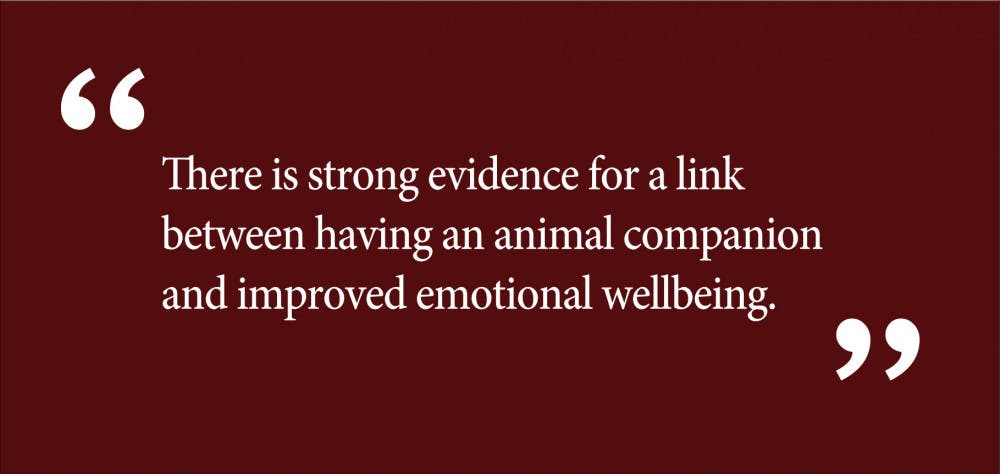Certain dorms at Brown are designated as quiet spaces. Certain dorms are sub-free. There’s Environmental Housing and International Housing and, as announced last semester, there are plans to build a somewhat nebulously-defined “wellness dorm.” So, to expand on these offerings, hear me out:
Cat. Housing.
Or Pet Housing, I guess, but that name implies that I’m also in support of allowing dog-specific dorms, a point which I’ll address later. Birds, guinea pigs and other small animals that don’t bring up as many allergen concerns should be allowed in all dorms, though that’s an argument for another column. And “Animal Housing” just bears unfortunate connotations that the University would probably prefer to avoid, so “Cat Housing” it shall be.
I envision one of the residential halls that is composed primarily of suites or apartments, such as Graduate Center or Young Orchard, as a site dedicated for students to keep rabbits, ferrets and especially cats with them on campus. Rooms that share an enclosed common area offer a safe way for these animals to roam around, providing more space than a 100-square-foot single. The resident who brings the pet would be its primary caretaker, taking on the duty of making sure it is cared for during the school year as well as on breaks. Students would have to sign contracts agreeing to take responsibility incurred for any damage that their pet might cause, a step no different from Brown’s pre-existing policy that makes students pay for any harm enacted upon their dorms.
Detractors of this proposal will, of course, immediately point to students with allergies. However, this ignores the reality that there are already students on Brown’s campus who, for various reasons, have received permission to have animals with them. An allergic student could enter a residence hall without knowing that they may be exposed to the dander that sets them off. Cat Housing would minimize that issue, though not eliminate it — students who have documented emotional support animals should not be required to live only in Cat Housing, as that would single them out from students who do not require such feline accommodations.
That said, Cat Housing would actually represent a victory for mental health advocates. There is strong evidence for a link between having an animal companion and improved emotional well-being. Moreover, if a student wishes to have an animal with them right now, they must first jump through the hoops of explaining their condition to the University and proving that it is severe enough to warrant exemption from regular pet-free policies. Having dorms designated as animal-friendly would give students the option to have their pets nearby without having to go through the drawn-out, emotionally exhausting process of displaying their mental illnesses for administrative approval.
Even for students without prior mental health concerns, animals provide a break from the daily stresses of life, something Brown has tacitly acknowledged through its Heavy Petting program, in which animals are brought to campus during particularly trying times such as finals and midterms. But, as has been written about before, Heavy Petting creates conditions that may place stress on the animals, an issue that can be avoided by creating a stable living environment. In fact, as a recent Boston Globe article points out, many animals undergo considerable emotional challenges when a student leaves for college. Cat Housing, then, might benefit both person and pet.
Though I know from firsthand experience that cats are capable of missing their people, I acknowledge that the Globe column’s canine-centric approach is somewhat tangential to my Cat Housing proposal, as I don’t believe a college is the best environment for a dog. A student busy with academics, work, extracurricular activities and all the other responsibilities of life at Brown would likely have little time to walk or take a dog out to do its business — problems avoided with cats. There are other issues with dogs too, like noise pollution; think about how many times you’ve heard your neighbor’s dog bark. Now consider how many times you’ve heard their cat meow. Sure, people in the same building might hear a cat in the suite below or above them, but complaining about that when you choose to live in Cat Housing is like signing up to Environmental Housing and then getting upset when you smell the compost pile out back. Finally, students seeking to hang out with a dog need only wait around on the Main Green until one of President Christina Paxson’s P’19 poodles appears. Cats are considerably harder to access.
Brown has long prided itself on being a progressive institution. The formation of Cat Housing, through its implications for human health and animal rights, will keep it deserving of that label. So come on, Brown — let the cats out of the bag, and into the (designated) dorms.
Caroline Mulligan ’19 can be reached at caroline_mulligan@brown.edu — send cat photos! Please send responses to this opinion to letters@browndailyherald.com and other op-eds to opinions@browndailyherald.com.





